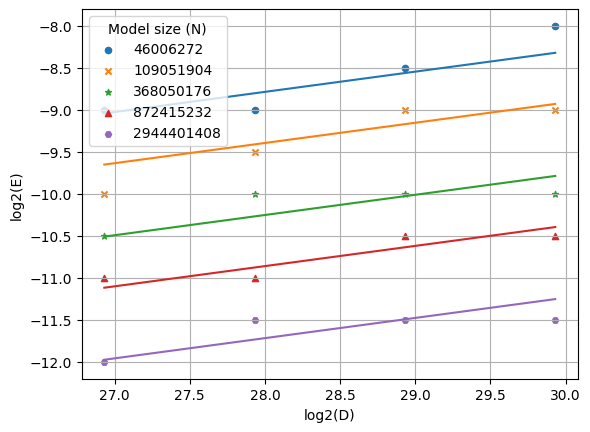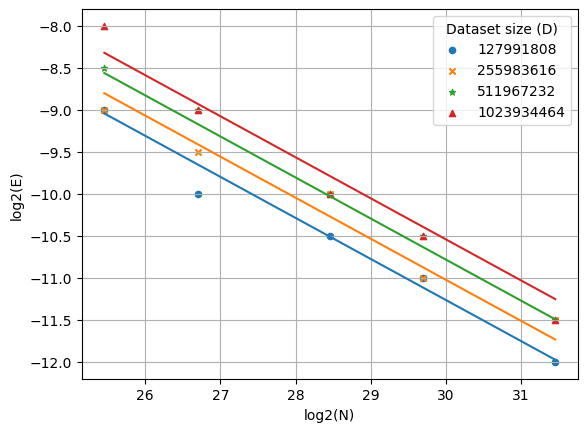Scaling Laws for Optimal LR and Batch Size - Part III
Sweep granularity matters
Introduction
Welcome back.
In Part I and Part II of this series, I fit scaling laws for optimal batch size B^* and optimal learning rate \eta^*, but found that the data scaling exponent differed from the StepFun paper, Li et al., 2025.
In Part IIb, I identified insufficient learning rate granularity as a possible culprit for the poor fit. In this post, I will upgrade the learning rate granularity to equal that of the Li et al., 2025.
Experiment Planning
I will start over with data collection, this time using grid data only. I will use n_layer = 6, 8, 12, 16, 24 as before, and generate N = 13 * 128^2 * n_layer^3 as before.1 I will use dataset sizes 128M, 256M, 512M, 1024M.
I will use batch sizes in powers of two between 32768 and 2097152 tokens, and learning rates in powers of 2^0.5 from 0.0078125 to 0.0001220703125, yielding G=91 grid points.
The total compute expenditure in FLOPs is
which is ~5x larger than the prior experiments and just over 10% of compute required to train LLaMA-1-7B. There are over 1800 runs in total.
Experiment Data
The data for the optimal (B, \eta) pairs is
N D B E Loss
86 46006272 127991808 32768 0.001953 3.880559
175 109051904 127991808 32768 0.000977 3.794820
252 368050176 127991808 65536 0.000691 3.714983
346 46006272 255983616 65536 0.001953 3.682230
436 109051904 255983616 65536 0.001381 3.582214
526 368050176 255983616 65536 0.000977 3.486761
620 46006272 511967232 65536 0.002762 3.518618
697 109051904 511967232 131072 0.001953 3.403666
786 368050176 511967232 131072 0.000977 3.287104
881 46006272 1023934464 131072 0.003906 3.384921
970 109051904 1023934464 131072 0.001953 3.256896
1059 368050176 1023934464 131072 0.000977 3.123393
1161 872415232 127991808 65536 0.000488 3.670941
1252 872415232 255983616 65536 0.000488 3.434034
1331 872415232 511967232 131072 0.000691 3.233707
1445 2944401408 127991808 32768 0.000244 3.611588
1524 2944401408 255983616 65536 0.000345 3.371229
1604 872415232 1023934464 131072 0.000691 3.058425
1693 2944401408 511967232 131072 0.000345 3.160028
1784 2944401408 1023934464 131072 0.000345 2.977672Fitted Scaling Law
Using the complete set of (N, D) pairs, the bootstrapped parameter-averaged fit is:
which is fairly close to the dataset exponents in the StepFun paper, Li et al., 2025, which were 0.571 and 0.307, respectively.
The difference in batch size proportionality constant can be attributed to a different tokenizer and dataset—I used the T5 tokenizer and the C4 dataset. The difference in the learning rate proportionality constant and parameter exponent can be attributed to the locked aspect ratio for my models.2
Visualizations
Next, we’ll recreate the visualizations in Figure 6 of the StepFun paper. The fitted scaling law for learning rate as a function of dataset size D is plotted below:
I also plotted the fitted scaling law for learning rate as a function of model size N:
Summary
In this post, I ran over 1,800 experiments and obtained the optimal (B, \eta) for each of twenty (N, D) pairs. I fit the scaling laws for optimal batch size and optimal learning rate, and I approximately recovered the data scaling exponents from Li et al., 2025. Lastly, I plotted the scaling law and recovered figures similar to Figure 6 of Li et al.
I use SwiGLU with d_ff = 3 * d_model and d_model = 128 * n_layer as before.
In other words, the ratio d_model/n_layer is constant, which impacts the fit.



